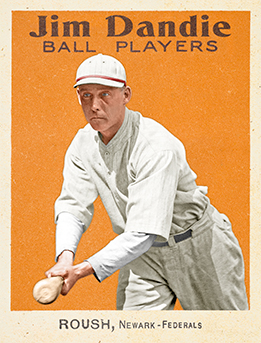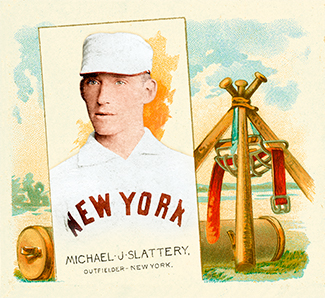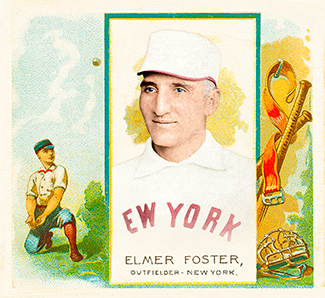- Series: 1888 Champion New York Giants
- City: New York
- Team: Giants
- League: National League
Michael J. Slattery (1866-1904) was an outfielder for five teams over five seasons, including the 1888 Champion NY Giants. He debuted for the Union Association’s Boston entry (the Reds) in 1884 during that league’s only season. Slattery returned to MLB in 1888 with the NL’s Giants for two years before jumping to the NY Player’s League team in 1890. He closed his career with the Cincinnati Reds and Washington Statesmen in ’91.
- Averaged .251 at the plate over his ML tenure
- Best year was in the PL, with a .307 BA, 126 hits, 5 HRs and 18 steals
- Series: 1888 Champion New York Giants
- City: New York
- Team: Giants
- League: National League
Elmer Ellsworth Foster (1861-1946) was an outfielder with the New York Metropolitans, New York Giants and Chicago Colts over a six year span beginning in 1886. The very rare baseballer who threw left and batted right, Foster achieved a career batting average of .187.
- One of the first five major leaguers born in Minnesota
- Played at Haverhill with future Hall of Famers Wilbert Robinson and Tommy McCarthy
- Noted for his speed on the base paths, Foster always had an explanation if caught stealing: “Why, I wasn’t a bit tired. Why should I have stopped running?”

- Series: Jim Dandie Feds
- City: Newark
- Team: Peppers
- League: Federal League
- Hall: National Baseball Hall of Fame
Edd J. Roush (1893-1988) was an Indiana farm boy who knew his own mind. He built a Hall of Fame career on doing things his way. Spring training? Not for Edd, he stayed in shape. Use a bat heavier than any other player? Why not? His farm-bred arm strength allowed him to hit the ball wherever he chose with the weight of the bat doing most of the work. Stand still in the box awaiting the pitch? Not for Edd. He'd move his feet after the ball left the pitcher's hand, positioning himself according to his read. Endure management's miserly ways? No, Edd would hold out every year for a fairer contract. He'd skip to pirate leagues (the Federals) if necessary to find a better salary, something he had done as a school-boy player in Hoosier country and continued throughout his long and storied major league tenure. It took a few years in the bigs and a curious impatience by renowned manager John McGraw to get Edd to Cincinnati and the stage on which he would set records. Twice he edged out Rogers Hornsby for batting titles. He led the Reds to the Series championship in 1919, only to have that accomplishment tarnished by scandal. There is little doubt he was right in asserting that his club was better than Chicago's and really won it fair and square. During his twelve years with the Reds, Roush's batting average was .331. He never struck out more than 25 times in a season. He was fast on the bases and a terror in center, regarded as perhaps the premier defender of the Dead Ball era with Tris Speaker the competition.
- McGraw sent young Edd from the Giants to Cincy in 1916 along with two other future Hall-of-Famers: Bill McKechnie and Christy Mathewson. Matty was tickled to get a manager position and Edd and Bill were thrilled to get out from under the tough taskmaster McGraw
- When Edd threw out the ball at the last game played at Crosley Field, Joe Morgan said Roush was “the best of us all.”
- Elected to Hall of Fame: 1962

- Series: Jim Dandie Feds
- City: St. Louis
- Team: Terriers
- League: Federal League
John Thomas Tobin (1892-1969) built a fine major league career in the outfield for four teams, primarily in his hometown of St. Louis with the Federal League's Terriers in that organization's two years competing with the AL and NL, 1914-15; then staying on with the Browns for nine campaigns. “Johnny” did himself proud with the Browns, compiling a .318 average. Over his tenure in the big leagues, his average was an excellent .309. Tobin's introduction to the big leagues came via his play for his employer, Bell Telephone. He was literally recruited by the Terriers from atop a pole. He quickly established himself in St. Louis as a popular guy, both with fans and writers. Johnny led his team of MLB castoffs from last in '14 to within an eyelash of the Federal League pennant in '15, earning him a spot on the Browns. Business Manager Branch Rickey thought Tobin needed some seasoning and shipped him to the Salt Lake City Bees for most of 1917, a move that bore the mark of Rickey's genius as Tobin tore up the Coast League, leading the circuit with 265 hits. He would go on to earn the plaudits of no less than teammate George Sisler who termed him “One of the best leadoff men I ever saw” and “the best drag-bunter anyone ever saw.” The crafty speedster began piling up great seasons in St. Louis. He hit .322 in '22 when the club fell just shy of the Yankees, the only team they couldn't beat. Eventually Tobin's speed faded a bit and he was traded to the Senators in 1926 where he played very little before moving on that season to the Red Sox. His finale in '27 was a fitting resurgence by a great hitter as Tobin hit .310 in 111 games.
- Walter Johnson was another fan: “Tobin is a batter of the old school, not unlike Willie Keeler in many respects. I am glad there are not more like him.”
- Johnny became a fixture in his hometown's baseball circles, coaching youth and semi-pro leagues. In 1958 the Baseball Writers Association of America named him to the St. Louis “All-Time All-Star” squad along with such luminaries as Musial, Sisler, Frisch, Hornsby and Dizzy Dean

- Series: Jim Dandie Feds
- City: Pittsburgh
- Team: Rebels
- League: Federal League
Michael William Menosky (1894-1983) earned the nickname “Leaping Mike” for his abilities in the outfield and had some fine years at the plate, particularly for the Red Sox, in his nine-year tenure in the majors. He got his chance with the Pittsburgh Rebels of the Federal League in 1914. The team was aptly named, being one of the “outlaw” clubs that vied with the two established circuits for two years. The Rebels had come into the league as the Stogies, the old Union Association team in the Steel City. In its 1912 incarnation, the club was known as the Filipinos, reflecting not a heretofore unknown Asian connection to baseball, but in honor of its manager Deacon Phillippe. Ah, the romance of the early game! Menosky put up very average numbers in Pittsburgh and then with the Senators, a stint interrupted in 1918 by the war in Europe. He came into his own with Boston where he finished his career from 1920-23. His first three years in Fenway saw Mike bat .297/.300/.283 playing as a regular. His final campaign saw a marked drop-off in offense as he slumped to .229 in only 84 games. These seasons in Beantown pumped up his lifetime batting average to a solid .278. Menosky had speed, witnessed by his 10 triples and 22 steals for Washington in 1917 and the 23 stolen bases for Boston in 1920 that ranked fourth in the AL. He was the Sox' regular left fielder his first two seasons and opened in center in 1922, but only played four games there. Boston released the veteran after the '23 season and Mike went west to play for the PCL's Vernon (southeast Los Angeles) team.
- Menosky became a probation officer after leaving baseball. He played an interesting “expert witness” role in a criminal case involving a defendant charged with hurling a rock through a Detroit railroad terminal window. When the judge was skeptical that the man had the arm for that misdeed, he called Mike to demonstrate what a major league outfielder could do. When Menosky failed to throw the missile the 250 feet required to reach the window, the judge dismissed the case, reasoning that if Mike couldn't do it, the poor suspect couldn't have either




